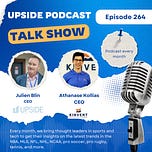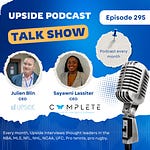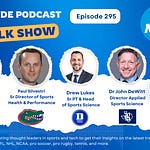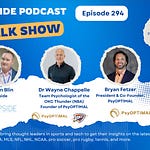This week we had the honor to interview Athanase Kollias, CEO of KINVENT, a company that helps sports and rehab professionals assess progress and build engagement and motivation.
Founded in 2017, KINVENT is a leading player in the fields of physical rehabilitation and sports biomechanics producing innovative measuring and training devices for the facilitation of every day and athletic movements. Of note, Raphaël Varane, who is a defender on the French national soccer team, 2018 World Cup Champion, and current Manchester United player, is one of their investors.
Here is the video interview with Athan Kollias. You can also listen to the audio interview located at the top of this page.
Kinvent offers a comprehensive solution combining an intuitive app, KINVENT PHYSIO, with a range of connected sensors, measuring strength, balance and range of motion of athletes. KINVENT solution helps fasten teams’ rehab process, and assess athletes in one minute. What is also unique about the KINVENT PHYSIO app is that it can understand the baseline of each individuals and uses data from 600,000 patients globally to compare individual data against similar demographics.
Pictures: KINVENT 11 sensors in 1 ecosystem
The display of the data recorded by the device sensors is transcribed by the KINVENT PHYSIO App, installed on any iOS or Android terminal. All sensors are capable to assess powerful muscular groups and record in real time, giving an instant biofeedback data on the app.
Picture: KINVENT products in action
Here are some pictures of the KINVENT mobile app and dashboard:
Picture: KINVENT mobile app and dashboard
Here is a video showcasing KINVENT products:
Here is a video showcasing KINVENT’s 3D Force plates, which are 3 Dimensional force plates combined with MOCAP bringing lab-level precision directly to the field. Unlike traditional force plates that only capture vertical force, 3D Deltas measure movement in all directions, providing a complete picture of an athlete’s or patient’s biomechanics. By combining 3D force plate technology with motion capture, it allows for real-time insights into (1) Change of direction efficiency, (2) Lateral movement & performance metrics (3) Injury risk assessment & rehab progress and (4) Sport-specific movement analysis.
Here is a video showcasing KINVENT’s K Power, an innovative hybrid sensor that combines IMU (Inertial Measurement Unit) and UWB (Ultra-Wideband) technology to deliver wireless and highly precise measurements of speed, distance, acceleration, and power in sports and rehabilitation settings.
KINVENT has developed advanced sensors and an application used by over 22,000 professionals across more than 75 countries. KINVENT has also built the world’s biggest database of grip assessments as they have collected between 50,000 and 70,000 grip assessments. As shown in the picture below, many other elite teams such as PSG, the Brazilian national soccer team, the French national soccer team, SD Padres (MLB), Houston Dynamo (MLS), Houston Texas (NFL), UFC, INSEP, just to name a few, are using their product today.
KINVENT products are also used by leading healthcare organizations and universities such as Mayo Clinic, HSS, Brooks Rehabilitation, Aspetar, Princeton University, just to name a few.
📝Show Notes: Through this interview with Athanase Kollias, we touched on his 2 latest products the 3D Deltas and K-Power. We also discussed how Kinvent approached product development differently with these new launches. We also touched on their plans for the next 12 months as well as how they intent to stay ahead of the curve in the sports performance tech market.
Best Quotes: Here’s some of the key discussion points and best quotes from our conversation with Athanase:
Q1. Let’s start with the Kinvent 3D Deltas — what’s unique about this product, and how do you see it impacting both rehab and performance workflows in elite sports environments?
“Until today, the vast majority of force plates on the market only measured the vertical component of force — which is useful, but not enough. As humans, we don’t just move vertically. In sports and life, we move multidirectionally. We sprint, cut, pivot, change direction. Most of our motion is horizontal, yet most tools have ignored that. That’s a major gap.”
“That’s why we developed the 3D Deltas. They allow us to capture movement across all three axes — X, Y, and Z — so we’re no longer limited to a two-dimensional understanding of human movement. And this isn't just a product for us — it's a legacy. It started as a dream my father, a biomechanist, had 30 years ago. He knew from his own work that athletes weren’t getting injured in controlled, vertical-only motions like countermovement jumps. Injuries and performance limitations usually show up during lateral cuts, sudden accelerations, or when changing direction under load. So we set out to build a system that could finally reflect the full nuance of real-world movement — and we paired it with Cassandra, our AI engine and motion capture system, to give a complete picture of what’s really happening on the field or in rehab.”
Q2. K-Power is your newest innovation — can you walk us through its core functionality and how it complements or integrates with your existing Kinvent ecosystem?
“K-Power is what I would call a hybrid performance and rehab tool. It’s designed to work both with barbell-based strength training and sprint-based movement analysis. It’s a small pod, lightweight and wireless, that tracks speed, acceleration, distance, and power — in both horizontal and vertical directions. For example, coaches can place it on a bar to measure velocity-based training during a bench press, or set it up behind a sprinter on a tripod to capture force-velocity profiles over 5m, 10m, or 40-yard sprints.”
“The goal with K-Power — as with all our new tools — is to give strength coaches and athletic trainers precise, usable data in real-world environments. That means on the turf, in the weight room, wherever they’re working. And unlike traditional cable systems, there’s no hardware tethering. It’s not just another IMU or barbell tracker — it’s engineered for accuracy and ease of use. We see K-Power as a perfect complement to the 3D Deltas and the rest of our ecosystem, allowing a continuous flow of insights from high-intensity field testing to rehab benchmarking to return-to-play programming.”
Q3. Kinvent has always positioned itself at the intersection of science and usability — how are you approaching product development differently with these new launches?
“That’s something we think about constantly. Historically, performance and rehab tools have either been too scientific — meaning they’re confined to research labs with PhDs interpreting results weeks later — or too simplistic to provide actionable value. We’re trying to bridge that gap. Our approach now is to make the data not only accurate and rigorous but also understandable and relevant for both the practitioner and the athlete.”
“AI plays a big role in that. We’ve been investing in AI for over four years, but we’ve recently accelerated our efforts. Cassandra, our AI engine, is designed to help users quickly extract insights — from identifying the weak link in a movement pattern to recommending next steps. But here’s the key: we don’t just want to say ‘you jumped 40 cm’ or ‘your sprint time improved by 0.2 seconds.’ We want the athlete to understand what that means. Am I improving? Am I at risk of injury? What should I do next? That’s where AI, motion capture, and our new products converge — to make science not just usable, but actionable.”
Q4. What does Kinvent’s AI roadmap look like in the future?
“We’ve already built our AI engine — it’s called Cassandra. Right now, Cassandra helps summarize data, identify weak links in movement patterns, and support motion capture analysis. It also plays a role in assisting practitioners with designing training programs. But that’s just the beginning.”
“Over time, Cassandra will become more capable — that’s part of our internal roadmap. We’re continuously feeding it more and better-quality data to improve its accuracy and usability. But because we’re a medical device company, we have to be very careful. AI can sometimes produce results that don’t make sense, so regulatory compliance and reliability are essential.”
“Eventually, we see Cassandra offering not just analysis, but actionable guidance — things like when a player is ready to return to play, what adjustments are needed in their rehab or training, or even early indicators of potential injury risk. But again, the key is building that on a solid foundation of clean, contextualized, high-quality data.”
Q5. Looking ahead to the next 12 months, what are your strategic priorities — whether that’s product development, market expansion, new partnerships, or deeper integration with pro teams and clinics?
“Without question, the U.S. market is our top strategic priority. We’ve built a strong base in Europe, but North America is the next big frontier for us — and we’re going all in. Our focus is on penetrating colleges, universities, hospitals, and clinics, and to do that, we’re building out a full U.S. team — sales, marketing, customer success, everything.”
“On the product side, our priority is AI integration. Cassandra is already helping practitioners summarize sessions, identify weaknesses, and assist with programming. But we want to go further — to deliver real-time decision support and eventually predictive insights. At the same time, we’re mindful that we’re a regulated medical device company, so we’re moving responsibly. AI can be powerful, but it can also go off the rails if not trained and validated properly. That’s why we’re investing heavily in data quality — clean, validated, contextual data — so our AI remains trustworthy and compliant.”
Q6. As sports performance and rehab become more data-driven, how is Kinvent leveraging trends like AI, cloud analytics, or remote monitoring to stay ahead of the curve?
“First, I’d say this: there aren’t enough of us. There are maybe four or five companies worldwide doing serious work at the intersection of sports science, technology, and rehabilitation. That’s not enough. We need more innovation, more competition — it’s the only way we move the field forward and educate the broader market.”
“Second, we believe that staying ahead means mastering the full stack: hardware, software, cloud infrastructure, data science, and AI. We control that entire value chain internally, across teams in France, Greece, and the U.S. That’s what allows us to move fast, adapt, and innovate with precision. We don’t outsource key technologies — we build them in-house.”
“With Cassandra, we’re building not just an AI that summarizes or visualizes, but one that interprets and guides. We’re developing insights that are field-relevant — that help determine when to ramp up load, when to hold back, when to return to play. But AI won’t do that alone — it needs rich, high-quality data. That’s why all our tools — the 3D Deltas, K-Power, our dynamometers — are designed to feed Cassandra with the kind of contextual, meaningful data it needs to deliver real value. We’re not just chasing buzzwords — we’re building the future of intelligent, athlete-centered rehab and performance.”
You may also like:
🔥Upside Chat: Athanase Kollias, CEO of KINVENT, a Leading Sports and Rehab Professional Assessments Company
This week we had the honor to interview Athanase Kollias, CEO of KINVENT, a company that helps sports and rehab professionals assess progress and build engagement and motivation.



















